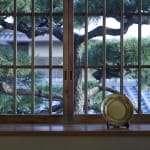Bernard Leach (1887–1979)
Plate
Sealed “SI” on foot
With a box signed by the artist (1928)
W22.3 x H3.7 cm
Further images
This plate is covered with a yellow glaze that has been scraped away in parts to create a series of lines and motifs circling the plate’s inner section. The shifting thickness of the yellow glaze combines with the color variations produced during firing to imbue the work with a softly-hued gradation. This is pleasantly accentuated by the reddish-brown ground that peaks out through the patterns. This plate’s designs are quite simple compared to other representative works with slip decorations. It also has a modest size and a plain shape more suitable for daily use.
The artist’s writing on the box dates this work to 1928. The monogram of the Leach Kiln is also imprinted inside the plate’s base. This suggests Bernard Leach made this plate at a kiln in St. Ives, southwest Cornwall, after his return to England in 1920. After an eleven-year stay in Japan, Leach moved his production base to England with the aim of combining the cultures of East and West in his capacity as a potter. However, he faced a variety of problems related to the changing environment and technical challenges. Works produced from the 1920s to the 1930s speak volumes about Leach’s laborious attempts to produce pottery that fused elements from traditional English and East Asian ceramic art. This plate is also a product of this challenging time and it provides a glimpse into the efforts that would eventually lead to Leach’s mature period during and after the war.
Bernard Leach (potter; 1887−1979)
Hong Kong-born British potter. A former painter. Inspired by Japan’s folk crafts’ aesthetics and learned pottery-making afterwards. Active in the Mingei Movement. Close to Yanagi Muneyoshi, Tomimoto Kenkichi, and Hamada Shoji throughout his life. His restrained and graceful style left great influence to modern Japanese crafts-making.
The artist’s writing on the box dates this work to 1928. The monogram of the Leach Kiln is also imprinted inside the plate’s base. This suggests Bernard Leach made this plate at a kiln in St. Ives, southwest Cornwall, after his return to England in 1920. After an eleven-year stay in Japan, Leach moved his production base to England with the aim of combining the cultures of East and West in his capacity as a potter. However, he faced a variety of problems related to the changing environment and technical challenges. Works produced from the 1920s to the 1930s speak volumes about Leach’s laborious attempts to produce pottery that fused elements from traditional English and East Asian ceramic art. This plate is also a product of this challenging time and it provides a glimpse into the efforts that would eventually lead to Leach’s mature period during and after the war.
Bernard Leach (potter; 1887−1979)
Hong Kong-born British potter. A former painter. Inspired by Japan’s folk crafts’ aesthetics and learned pottery-making afterwards. Active in the Mingei Movement. Close to Yanagi Muneyoshi, Tomimoto Kenkichi, and Hamada Shoji throughout his life. His restrained and graceful style left great influence to modern Japanese crafts-making.







